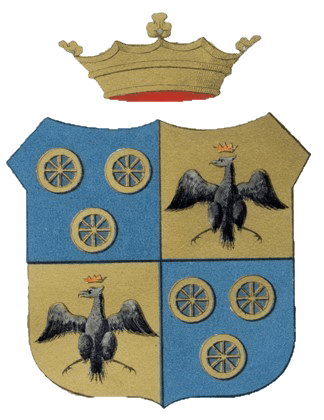The Inghirami
Family
The Inghirami family is one of the oldest and most distinguished families from Volterra, with roots tracing back to Saxony. Their presence in Tuscany has been documented since the 10th century, when they arrived in the region accompanying Otto I the Great, Emperor of the Holy Roman Empire.
The Inghirami family crest is a symbol of their prestige and long-standing history:
- First and Fourth Quarters: Gold, with a black eagle crowned in gold. The eagle symbolizes power and nobility, reflecting the family’s connection to the Empire.
- Second and Third Quarters: Blue, with three gold wheels arranged 2 and 1. The wheels represent movement and progress, indicating the family’s dynamism in their affairs and ventures.
Roots in Tuscany
Once settled in Volterra, the Inghirami family became part of the city’s patrician class, gaining significant social and political influence. Over time, the family expanded to other Italian cities, such as Rome and Prato, where they became prominent in various fields.
Prato Branch
The Prato branch of the family included notable figures like Gimignano Inghirami, who left a mark on local history. The Inghirami family in Prato was well-known for its involvement in commerce and the wool industry, one of the city’s main economic drivers.
Volterra Branch
In Volterra, numerous prominent members of the family stood out, including Curzio, Francesco, Giovanni, and Tommaso Inghirami. These individuals were influential in politics, art, and culture, making significant contributions to the family’s reputation and prestige.
Notable Members of the Inghirami Family
Paolo di Giovanni Inghirami
He was the first in the family to hold the office of Prior in 1439. From that point onward, many Inghiramis served in the highest magistracy at various times, solidifying their influence over public life in Volterra.
Antonio di Antonio Inghirami
He served as Apostolic Abbreviator, while Inghiramo di Giovanni held the role of Scribe of the Sacred Penitentiary. Both were considered among the most learned men of the Papal Court, recognized for their deep knowledge and expertise in ecclesiastical matters.
Monsignor Tommaso Inghirami (known as Phaedra)
Tommaso Inghirami, also known as Phaedra, was one of the family’s most distinguished members. Under the patronage of Lorenzo de’ Medici, he devoted himself to oratory and poetry, excelling in philosophy, history, and law.
In 1495, Pope Alexander VI sent him as an ambassador to Emperor Maximilian I, who awarded him the titles of Count Palatine and Poet Laureate, and granted him the privilege of adding the imperial eagle to his crest. Pope Julius II appointed him as the Vatican librarian, then later as personal secretary and secretary to the College of Cardinals. Tommaso Inghirami stands as one of the foremost figures of Italian humanism.
Curzio Inghirami
Born in Volterra in 1614, Curzio made his mark as a historian and enthusiast of antiquities. He authored The History of the Bishops of Volterra and dedicated himself to the preservation of Etruscan monuments, all while holding significant public roles. His work as a legislator and scholar earned him an honored place in the city’s historical memory.
Jacopo di Giovanni Inghirami
Perhaps the most celebrated member of the family, Jacopo joined the Order of Santo Stefano in 1581 and mastered military arts under the French crown. He was later appointed Admiral of the Order’s fleet and brought enduring glory to the small Tuscan navy with numerous naval victories, such as the capture of fortresses in Albania, Greece, and on the Barbary Coast, where he became a terror to Turkish and Barbary forces.
His most brilliant feat was the capture of Bona, an action so memorable that it inspired a poem. In recognition of his achievements, Ferdinand I granted him the fiefdom of Montegiovi with the title of Marquis, while Cosimo III established for him the priory of the Holy Sepulchre within the Order of Santo Stefano.
Legacy and Heritage
The Inghirami family has left an indelible mark on the history of Volterra and beyond. Their legacy is filled with achievements across various fields—from politics to culture, from diplomacy to warfare. Their historic residences, such as the Villa of Scornello, stand as living testaments to their prestige and lasting influence.
Even today, the Inghirami are remembered not only for their accomplishments but also for their contributions to the culture and history of Tuscany and Italy. Their heritage lives on in the stories and traditions tied to the places where they made their mark.
